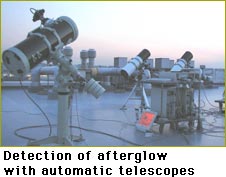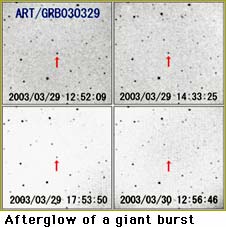Scientists have long wanted to observe the moment when a star collapses into a black hole. And indeed, a phenomenon that seems to correspond to that moment has emerged: a celestial event called a gamma-ray burst. During the 1960s, at the height of the Cold War, the United States launched artificial satellites to detect gamma rays discharged during nuclear-weapons tests, in order to monitor the nuclear activities of the Soviet Union. Fortunately, there were no gamma rays coming from Earth, but instead scientists discovered a mysterious phenomenon in which from time to time cosmic gamma rays rushed like tsunamis. This phenomenon was named a gamma-ray burst, but the timing and location of these bursts remained unpredictable. In addition, they were very brief, brightening for just a few seconds or minutes, and then disappearing. Even when we were fortunate enough to able to determine where the bursts would likely occur, when we searched those areas with telescopes later we could not find any suspicious-looking celestial bodies. Finally, in 1997, an Italian satellite managed to pinpoint the location of a gamma-ray burst just a few hours after it occurred. Using optical telescopes on the ground, astronomers were then able to discover the afterglow of an explosion that it faded far more slowly than the gamma rays. After the afterglow had disappeared, the location was examined in visible light. What turned up was an extremely distant galaxy - a galaxy that existed when the universe was still young. Consequently we learned that gamma-ray bursts are likely big explosions that happen at the farthest corners of the universe. The fact that we can detect gamma rays that are discharged so far away leaves no doubt that these explosions release gigantic amounts of energy.
|
|||||||
|
|||||||

